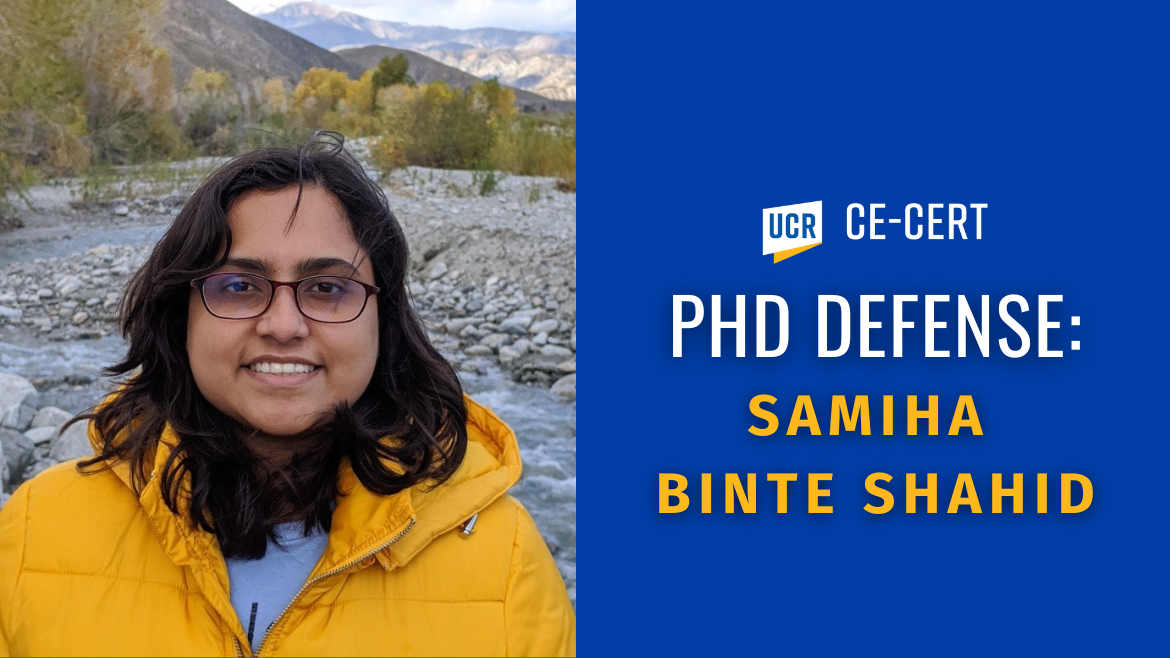
Join us for a presentation and defense by Samiha Binte Shahid, as she defends her Ph.D. thesis at the Center for Environmental Research and Technology (CE-CERT).
Details: May 31st, 2024 @ 10:30 AM, CE-CERT RM 105 and Zoom (https://ucr.zoom.us/j/97237948203, Meeting ID: 972 3794 8203)
Title: Improving the representation of non-methane organic gases (NMOG) in emissions inventories and gas-phase chemical mechanisms for better prediction of secondary organic aerosol (SOA).
Abstract: Emission estimates indicate that biomass burning (BB) is the second largest source of non-methane organic gases (NMOGs). NMOGs are precursors to ozone and secondary organic aerosol (SOA), both of which degrade air quality and adversely affect human health. SOA is formed when NMOGs oxidize and form lower volatility compounds. However, the incomplete representation of the NMOGs in BB inventories leads to missing reactive carbon and poor simulation of the impact of BB on air quality and climate.
This dissertation leverages the emissions data from the recent laboratory and field campaigns, previously scattered across numerous journals, to develop the Next-gen Emissions InVentory expansion of Akagi (NEIVA). NEIVA provided recommended emission factors (EFs) for ~1500 chemical species including inorganic gases, NMOGs, particulate matter (PM) and PM constituents. Additionally, NEIVA generates NMOG emission profiles for several gas-phase chemical mechanisms (e.g., SAPRC, GEOS-Chem, MOZART), enhancing their application in modeling. The expanded NMOG representation in NEIVA includes over 400 compounds for boreal forests, temperate forests, chaparral, peat, and crop residue, with less than 5% of compounds remaining unidentified. Moreover, the increased data count for certain NMOGs statistically strengthens the recommended EF. Compared to existing inventories, NEIVA exhibits a ~38% increase in total OHR. Its volatility basis set distribution includes intermediate volatility compounds (3.5 < log C* < 6.5), filling a gap present in current inventories.
This dissertation introduces a new model framework ‘SAPRC-F0AM’ (Framework for 0-D Atmospheric Modeling), integrating the SAPRC mechanism with F0AM and incorporating a thermodynamic SOA model with parameters from the CMAQ-AERO-07 module. It investigates how NMOG profiles from different inventories affect BB plume chemistry and SOA formation. This model setup is initially employed to evaluate the performance of standard and revised SAPRC mechanisms (S07, S18 and S22) with standard and revised SOA parameters for oxygenated aromatics (phenol, cresol, 2,4-dimethyl phenol) using data from 14 chamber experiments. Ambient BB plume simulations show sensitivity of OH (hydroxyl) and RO2 (peroxyl radical) levels, primary NMOG decay and SOA formation to different NMOG profiles. The simulation using NEIVA-based inputs and the newer gas-phase mechanism shows better agreement with the observed data. This underscores the contribution of the research presented in this dissertation towards enhancing the accuracy of modeling BB emissions and their impact on air quality.